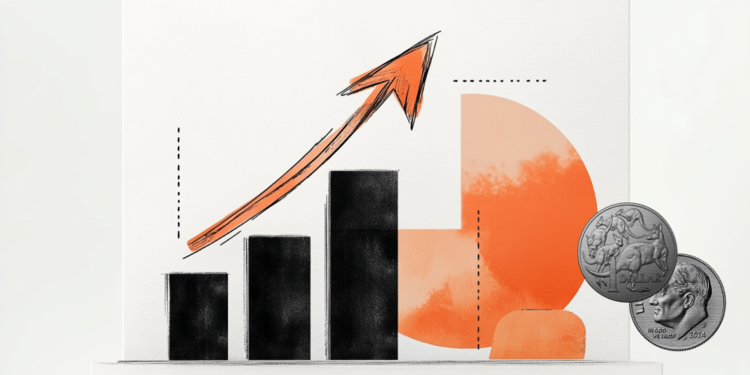- AUD/USD surges to near 0.6530 as antipodeans advance ahead of trade talks between the US and China.
- Upbeat China Trade Balance data for May has also strengthened the Aussie Dollar.
- Easing US labor market conditions have weighed on the US Dollar.
The AUD/USD pair is up almost 0.55% to near 0.6530 during European trading hours on Monday. The Aussie pair strengthens as antipodeans outperform ahead of trade negotiations between the United States (US) and China later in the day.
Australian Dollar PRICE Today
The table below shows the percentage change of Australian Dollar (AUD) against listed major currencies today. Australian Dollar was the strongest against the US Dollar.
| USD | EUR | GBP | JPY | CAD | AUD | NZD | CHF | |
|---|---|---|---|---|---|---|---|---|
| USD | -0.36% | -0.36% | -0.58% | -0.16% | -0.50% | -0.70% | -0.25% | |
| EUR | 0.36% | -0.02% | -0.21% | 0.18% | -0.13% | -0.36% | 0.09% | |
| GBP | 0.36% | 0.02% | -0.12% | 0.20% | -0.09% | -0.34% | 0.11% | |
| JPY | 0.58% | 0.21% | 0.12% | 0.42% | 0.03% | -0.18% | 0.20% | |
| CAD | 0.16% | -0.18% | -0.20% | -0.42% | -0.36% | -0.54% | -0.10% | |
| AUD | 0.50% | 0.13% | 0.09% | -0.03% | 0.36% | -0.24% | 0.21% | |
| NZD | 0.70% | 0.36% | 0.34% | 0.18% | 0.54% | 0.24% | 0.45% | |
| CHF | 0.25% | -0.09% | -0.11% | -0.20% | 0.10% | -0.21% | -0.45% |
The heat map shows percentage changes of major currencies against each other. The base currency is picked from the left column, while the quote currency is picked from the top row. For example, if you pick the Australian Dollar from the left column and move along the horizontal line to the US Dollar, the percentage change displayed in the box will represent AUD (base)/USD (quote).
The Australian Dollar (AUD) gains on hopes that US-China trade discussions will be smooth and delegates from both nations will try to secure a bilateral deal soon. Over the weekend, US President Donald Trump expressed confidence in a post on Truth.Social, that meeting between his top negotiators and Chinese representatives will go very well.
Given that the Australian economy relies heavily on its exports to China, positive outcomes from Washington-Beijing talks will be favorable for the Australian Dollar (AUD).
Additionally, upbeat China Trade Balance data has also provided strength to the Australian Dollar. During Asian trading hours, the National Bureau of Statistics of China reported that the Trade Balance (CNY) came in higher at CNY743.56 billion in May, compared to the previous surplus of CNY689.99 billion seen in April.
Meanwhile, the US Dollar (USD) faces a sharp selling pressure ahead of US-China talks and signs of underlying weakness in the domestic labor market data. The US Nonfarm Payrolls (NFP) report for May showed that the cumulative addition of job-seekers in March and April was lower by 95K than what was previously reported. However, the addition of fresh workers in May was slightly higher at 139K, compared to estimates of 130K.
This week, investors will focus on the US Consumer Price Index (CPI) data for May, which will be released on Wednesday.
US Dollar FAQs
The US Dollar (USD) is the official currency of the United States of America, and the ‘de facto’ currency of a significant number of other countries where it is found in circulation alongside local notes. It is the most heavily traded currency in the world, accounting for over 88% of all global foreign exchange turnover, or an average of $6.6 trillion in transactions per day, according to data from 2022.
Following the second world war, the USD took over from the British Pound as the world’s reserve currency. For most of its history, the US Dollar was backed by Gold, until the Bretton Woods Agreement in 1971 when the Gold Standard went away.
The most important single factor impacting on the value of the US Dollar is monetary policy, which is shaped by the Federal Reserve (Fed). The Fed has two mandates: to achieve price stability (control inflation) and foster full employment. Its primary tool to achieve these two goals is by adjusting interest rates.
When prices are rising too quickly and inflation is above the Fed’s 2% target, the Fed will raise rates, which helps the USD value. When inflation falls below 2% or the Unemployment Rate is too high, the Fed may lower interest rates, which weighs on the Greenback.
In extreme situations, the Federal Reserve can also print more Dollars and enact quantitative easing (QE). QE is the process by which the Fed substantially increases the flow of credit in a stuck financial system.
It is a non-standard policy measure used when credit has dried up because banks will not lend to each other (out of the fear of counterparty default). It is a last resort when simply lowering interest rates is unlikely to achieve the necessary result. It was the Fed’s weapon of choice to combat the credit crunch that occurred during the Great Financial Crisis in 2008. It involves the Fed printing more Dollars and using them to buy US government bonds predominantly from financial institutions. QE usually leads to a weaker US Dollar.
Quantitative tightening (QT) is the reverse process whereby the Federal Reserve stops buying bonds from financial institutions and does not reinvest the principal from the bonds it holds maturing in new purchases. It is usually positive for the US Dollar.
Read the full article here








